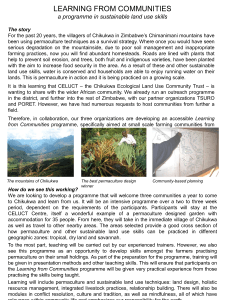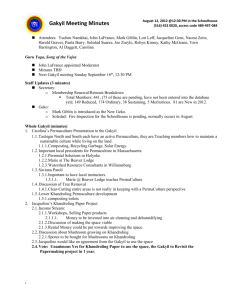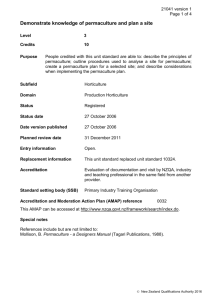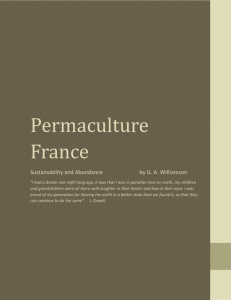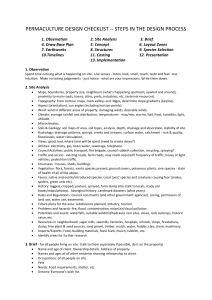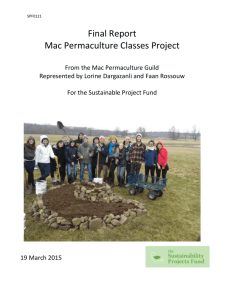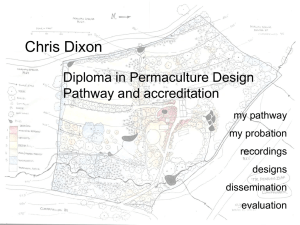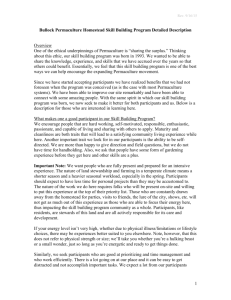Facilitator: Lisa Swennen Location: Butterfly Space, Nkhata Bay
advertisement
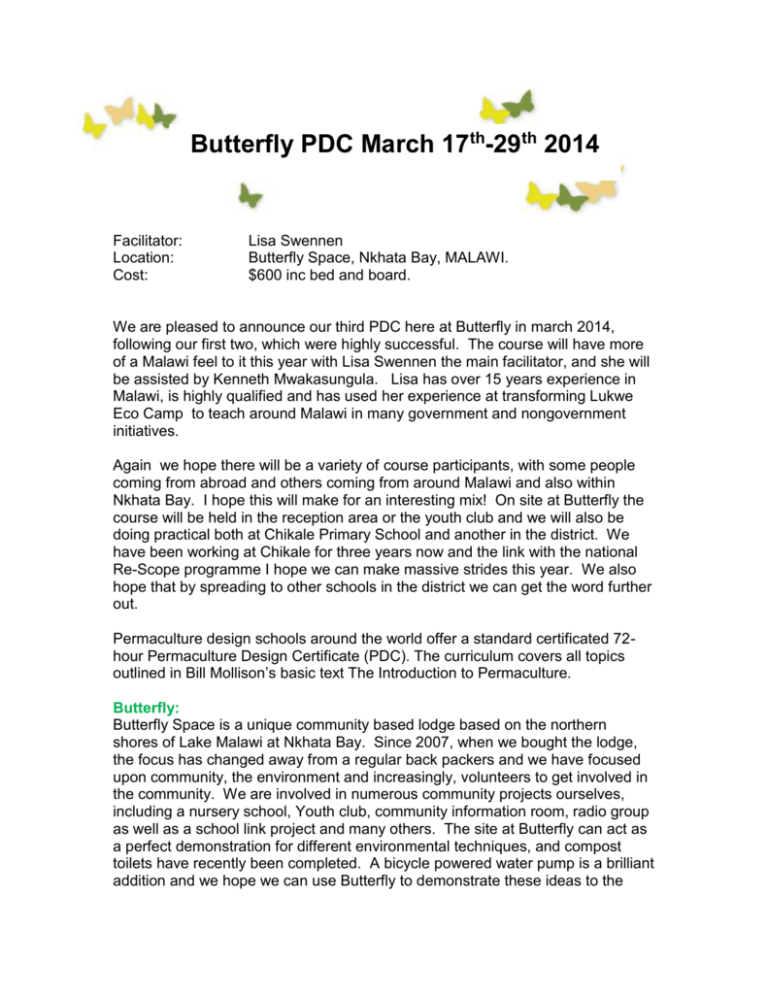
Butterfly PDC March 17th-29th 2014 Facilitator: Location: Cost: Lisa Swennen Butterfly Space, Nkhata Bay, MALAWI. $600 inc bed and board. We are pleased to announce our third PDC here at Butterfly in march 2014, following our first two, which were highly successful. The course will have more of a Malawi feel to it this year with Lisa Swennen the main facilitator, and she will be assisted by Kenneth Mwakasungula. Lisa has over 15 years experience in Malawi, is highly qualified and has used her experience at transforming Lukwe Eco Camp to teach around Malawi in many government and nongovernment initiatives. Again we hope there will be a variety of course participants, with some people coming from abroad and others coming from around Malawi and also within Nkhata Bay. I hope this will make for an interesting mix! On site at Butterfly the course will be held in the reception area or the youth club and we will also be doing practical both at Chikale Primary School and another in the district. We have been working at Chikale for three years now and the link with the national Re-Scope programme I hope we can make massive strides this year. We also hope that by spreading to other schools in the district we can get the word further out. Permaculture design schools around the world offer a standard certificated 72hour Permaculture Design Certificate (PDC). The curriculum covers all topics outlined in Bill Mollison’s basic text The Introduction to Permaculture. Butterfly: Butterfly Space is a unique community based lodge based on the northern shores of Lake Malawi at Nkhata Bay. Since 2007, when we bought the lodge, the focus has changed away from a regular back packers and we have focused upon community, the environment and increasingly, volunteers to get involved in the community. We are involved in numerous community projects ourselves, including a nursery school, Youth club, community information room, radio group as well as a school link project and many others. The site at Butterfly can act as a perfect demonstration for different environmental techniques, and compost toilets have recently been completed. A bicycle powered water pump is a brilliant addition and we hope we can use Butterfly to demonstrate these ideas to the wider community. We have also started implementing some Permaculture ideas at both the nursery school and the local Primary School, where a rainwater harvesting tank is also in use during the rainy season. We have many more ideas if we have the willing workers! Butterfly is also a fully functioning lodge, with a variety of accommodation, showers and bar and restaurant facilities. There are always a number of volunteers staying and helping out either with our projects or on their own initiative and this make it a vibrant community space. Leiza Swennen Leiza trained at a PDC in Fambidzani, Zimbabwe and is influenced by Ben Law of the UK. She has been living in Malawi since 1996, putting into practice what she had learnt, at Lukwe near Livingstonia. During this time she has graduated with a Diploma in applied Permaculture. Leiza lives with her family there at Lukwe, where she has focused upon edible forest gardening, landscape design, community, education, conservation, ecosanitation and water. Away from Lukwe Leiza has been responsible, alongside the Malawian Government, for designing practical curriculum content and demonstrations at Primary Schools. Designing ecosanitation is another area of expertise. Leiza lives with her family at Lukwe and enjoys mostly watching her son, Manu, happily growing up in a food forest. What is Permaculture? Permanent Culture (Permaculture) is the permanent behaviour of the natural forest. The forest has survived for millions of years because it has a culture for survival which is supported by a diversity of community members (plants, animals and other non living elements). It is this culture of the natural forest that Permaculture tries to bring into designing our everyday living systems. “Permaculture philosophy is one of working with, rather than against nature; of protracted and thoughtful observation, rather than protracted and thoughtless action; of looking at systems in all their functions rather than asking only one yield of them; of allowing systems to demonstrate their own evolution.” Bill Mullion 1990 (Co-founder of Permaculture philosophy) “ A philosophy of cooperation with nature and each other, of caring for the earth and people, presents an approach to designing environments which have the diversity, stability and resilience of natural systems, to regenerate damaged land and preserve environment which are still intact” (David Holmgren 1990 Cooriginator of Permaculture) According to Mollison Permaculture is a practical concept applicable from a balcony to the farm, from the city to the wilderness, enabling to establish productive environments providing our food, energy, shelter, material and nonmaterial needs, as well as the social and economic infrastructures that will support them. It is a synthesis of ecology, geography, observation and design. Permaculture encompasses all aspects of human environments and culture, urban and rural, and local and global impact. It involves ethics of earth care because the sustainable use the land cannot be separated from lifestyle and philosophical issues. It encourages the restoration of balance of our environments through the practical application of ecological principles. In the broadest sense, Permaculture refers to land use systems and lifestyle options which utilise resources in a sustainable way. A Global Permaculture Movement has emerged since the 1960s in response to David Holmgren and Bill Mollison ideas and those who developed them further such as Masanobu Fukuoka (Do nothing farming,” Japan) Rosemary Morrow, (Australia), Emilia Hazelip (Synergistic agriculture, Pyrenees, France) Patrick Whitefield, Joseph “Sepp” Holzer (Holzer Permaculture, Austria,”) Allan Savoury (Holistic Resource Management, Zimbabwe/ USA), etc. Permaculture organisations have been established worldwide. However it is in Africa where Permaculture promises to give maximum benefit to the ordinary people, helping them to ensure food security, that it is least known. Permaculture Ethics Ethics of Permaculture provide a sense of place in the larger scheme of things, and serve as a guidepost to right livelihood in consent with global community and the environment, rather than individualism and indifference. Care of the Earth This ethic includes all living and non-living things, plants, animals, land, water and air. Recognising the earth as the source of life and that mankind is part of the earth, and not apart from it. Agriculturists traditionally exploit soil, plants and animals, which creates problems, both internally e.g. diseases in plants, soil erosion, declining long term production and externally e.g. pollution from fertilizers, human diseases originating from factory farming. Care of the People Promote self-reliance and community responsibility, access to resources necessary for existence. Supporting and helping each other in ways that harm neither ourselves nor the planet and develop healthy societies. This includes selfbelief, building independent and resilient individuals, and communities who see solutions to their problems coming from within themselves. Sharing of resources, setting limits to population and Consumption To help others achieve their needs and reduce consumption. Use the earth’s limited natural resources in ways that are equitable and wise. For instance it is hypocritical to pretend to save forests, yet we buy daily newspapers and packaged food; and to adopt a diet which calls for broad scale food production. Give away surplus time, labour, information, and energy to achieve the aims of earth and people care. Permaculture Laws and Principles As a design science Permaculture follows some laws and principles which help come up with organised land designs some of which are: Relative location of elements Multiple function of elements Biological resources, maximum use of resources Energy flow Maximum diversity Stacking in space and time/succession Cooperation not competition Scale Maximizing yields and minimising energy Edge effect ecotones Work with nature instead of against it/ learn from nature Quality is economy Demonstration is authority Personal responsibility e.g. each person on this planet must take responsibility for her/his carbon footprint. “Man did not weave the web of life; he is merely a strand in it. Whatever he does to the web, he does it to himself. ...to harm the earth is to heap contempt upon the creator. ..Contaminate your bed, and you will one day suffocate in your own waste.” (Chief Seattle, 1854, responding to a US government offer to buy Indian land) Curriculum for the 72- Hour Permaculture Design Course (PDC) 1. Introduction 1.1 Historical background to Permaculture, worldwide, relationship with African indigenous agriculture and indigenous knowledge systems (IKS). 1.2 Why learn the Permaculture concept? Characteristics, definitions, ethics, laws and principles of Permaculture. 1.3 Preparing and presenting a sketch BEFORE MAP of each participant’s homestead. 2. Ecosystems Blocks 2.1 Permaculture base is ecology 2.2water cycle, mineral cycle, energy flow, succession and limiting factors to energy flow. 3. Resource Assessment 3.1 Situational analysis, transect walks and models 3.2 Water management and harvesting techniques, A-frame construction, swales, divergent drains application and practicals. 4. Principles of Design 4.1 Procedures skills and techniques 4.2 Observations, sectors, zones, zoning, deductions, maps, etc 4.3 Taking advantage of different micro-climates in design 4.4 Reduction of risks, energy use and selection of appropriate plants to implement on particular 4.5 Observing different microclimates and creating various microclimates. 5. Soils 5.1 Traditional soil classification. 5.2 Observation of various soils and relationship to plant and animal life. 5.3 Types of soil erosion damage and types of soil repair. 5.4 Water in relationship to soil and soil rehabilitation. 5.5 Soil improvement techniques- mulching, compost making, double digging, liquid manure, fertility trench, Indigenous Microorganisms (IMO), Effective Microorganisms (EM), Oriental Herbal Nutrient (OHN) 6. Plant Uses in Permaculture 6.1 Nursery practice, propagation methods and practice e.g. budding, grafting, layering, etc. 6.2 Forests, guilds as air-conditioners, food, diggers, mulches, nitrogen fixers, silt traps, windbreakers, etc 6.3 Design food forests by mimicking natural forests. 7. Patterns in Nature 7.1 Creating highly productive design/landscapes by integrating nature patterns e.g. spirals, linear, circles, Indian mandala shapes, etc 8. Productive Landscapes/ Designs 8.1 Indigenous Knowledge Systems (IKS) of soils, water use and nutrients has always been sustainable. 8.2 Homebuilding and siting with productive landscape, comfort, health with energy consumption in mind. 8.3 Food gardens for the city and countryside. 8.4 Food forests. Animal integration in the food forests: chickens, ducks, bees, turkeys, rabbits, guinea pigs and pigs. 8.5 Alley cropping and integrating large animals into your design 8.6 Dry land Farming Techniques: principles of erosion control; strategies, bunds, minimum till, conservation farming, well watered garden, potholing, no till tied ridges, no till tied furrows, mulch farming/ripping, mixed cropping, intercropping, strip cropping, etc 8.7 Natural forest creation/regeneration for provision of firewood, dyes, medicine, fibre, oils, incomes, etc. Conserving remnant forests to build up corridors and various ways of promoting their growth 9. Productivity and Sustainability 9.1 Weed management to acceptable levels. 9.2 Integrated Pest Management (IPM) intelligent strategies in controlling pests. Role of predators. Organic remedies in pest management. 9.3 Vegetable and herb gardens- mandala garden design and construction, keyhole beds, no dig beds, banana circles as guilds, herb spirals, organic materials and mulches. 9.4 Designing for disasters-drought, fire, storms, war, floods, earth quake, etc so that the landscape recovers speedily. 9.5 Aquaculture production systems-fish, water plants, water birds, water animals, etc 9.6 Biotechnology and its effects including recent GMO information. 10. Self-sufficiency 10.1 Building self-sufficient communities; country skills e.g. weaving, crafts, small scale excess food processing and packaging, herbal oils processing and marketing. 10.2 Ethical investments and the LETS system. 10.3 Holistic Goal formation 10.4 Preparing and producing management and development action plans including monitoring and evaluation for the Permaculture design. 10.5 Final presentation of an AFTER MAP of each participant’s Permaculture design. Major References Holmgren David 2002, Permaculture Principles and Pathways Beyond Sustainability, Holmgren Design Services, Hepburn, Victoria, Australia. Mollison Bill 20004 Introduction to Permaculture, Tagari Publications, Australia. Morrow Rosemary 2006 Earth User’s Guide to Permaculture, Kangaroo Press, Sydney, Australia. Elwell Henry Dr and Maas Anita 1998 Natural Pest and Disease Control, Mambo Press, Gweru, Zimbabwe. Calibre of Participants: Clientele : Peasant farmers, small urban plot holders, Agritex officers, children, undergraduates, post graduates, ordinary urban dwellers, etc. Groups will have to be used in order to deliver information appropriate to a particular education level group. Educational qualification is not a barrier at all, but participants should be grouped into 3 education level groups’ as follows (a) Those that never went to school can be in their own class. (b) Those with only primary education can be on their own and there is no problem in having 4 or 5 people who cannot read or write in this group. My experience is that it does not delay the progress of the lessons. (c) Those that did secondary can be in this final group where it is hoped some more committed individuals will develop into future trainers. Class Size: A minimum of 8 participants to a maximum of 35 can be handled by one facilitator and above 35 second facilitator can be brought in because of the hand on activities in some of the topics. Proposed Courses Permaculture courses are quite flexible as long the direction is to complete the 72- hour stipulated for a full course which can be continuously for two weeks without break or in one week segments. In some cases it can be spread over seven weekends or whatever periods are identified. The Timetable Day 1 Welcome, introductions, expectations, fears and housekeeping. Overview of Permaculture Ethics and laws of Permaculture Principles of Permaculture. Permaculture a true way of life (video) Day 2 Ecological processes. Ecological Processes Practicals. Patterns in Nature Using patterns in designing Synergistic Agriculture Emilia Hazelip (Video) Day 3 Situational analysis Transect Walks and mapping practicals. Presentation of mapping. Terraced agriculture, Sepp Holzer (video) Day 4 Construction and use of A-frame in water harvesting. Soil basic test and components Swales pegging and digging Aquaculture, (Sepp Holzer) Day 5 Zones, zone 0 and zone 1 Zone 2, 3, 4, and 5. Zoning groups, practicals. Presentations of zones Permaculture in Practise. (Video) Day 6 Windbreaks Design a windbreak. Plants and their uses. How to establish a food forest. (video) Day 7 Soil improvement techniques. Soil improvement practicals and presentations. Visit a site for analysis Practical implementation on the visited site Introduction to main design of the course, The after Map. Working on a practical project of choice as groups. Day 8 Home design visit and analysis. Intensive area design. Working on the after map as individuals. Global Gardner, Temperate (Bill Mollison video) Day 9 Dry Land farming techniques. Dry Land farming techniques practicals. Nursery Establishment. Nursery techniques practicals. Global Gardener, Dry Land (Bill Mollison, video) Day 10 Integrated Pest Management (IPM) Integrated Pest Management (cont) Companion Planting. Small design presentation. Polishing up the main design. Garbage Warrior ( video) Day11 Holistic Goal Formation. Plans of action. Plans of action group work. How Cuba survived the Pick Oil. (video) Day 12 Report on the plans of action done in groups. Presentation of individuals’ main designs of the course. Course feedback through evaluation form. Certification. NB 1. Participants must attend 70% of the 72-hour course to receive their certificates 2. Students must design a private home by individual work and a larger piece of land by group work. All groups will work on the same large land. Facilitators One facilitator for a group not exceeding 35 participants. Two or more facilitators for a class of more than 35 participants. Practical Work Plant identification and propagation techniques. Construction and using of A-frame on swales. Water planning and conservation Sheet mulching the garden in zone 1 Site analysis Compost making, double digging, fertility trench, making IMO probiotics Primary Site for group design Garden design Home design School design Provisions & Expectations: Butterfly will provide all the equipment needed for the smooth running of the course, and the lunchtime meals throughout the course. A dormitory bed will be provided for those participants that are staying and also breakfast and evening meal eaten at the lodge. Drinks and extra things ordered from the lodge would cost extra and are the responsibility of the individual. Conduct & Behaviour The national language in Malawi is Chi Chewa, yet in Nkhata Bay it is Chi Tonga that is spoken. Most people have a decent command of English but if you want to learn the greetings then there are no shortages of willing teachers and it is always appreciated. Female visitors should be aware that in the towns and villages, it is normally respectful to have your knees and your mid-riff covered (and in some cases, your shoulders). Malawi is a conservative faith based society and we encourage people to understand and respect this. Thank you for you co-operation. Contact Details: Josie Redmonds: Postal Address: P.O. Box 211, Nkhata Bay, Malawi Mobile Number +265 (0)999156335 Email Address: josie.redmonds@gmail.com : Leiza Swennen: Postal Address: P.O. Box 20, Livingstonia, Malawi. Mobile Number +265 (0)995752839 Email Address: earthcare@arica-online.net Butterfly Mobile Number: 0995275431 “Hidden in our hearts is a longing to live deeply and with purpose and joy, to know and to be known, to be concerned with another; and to make a difference. In this dance of giving and receiving, we create our community, our World and ourselves” www.butterfly-space.com www.facebook.com/butterfly.space.malawi
